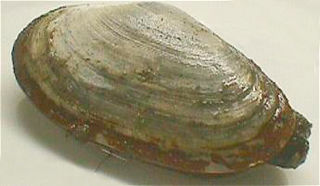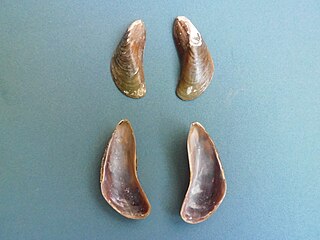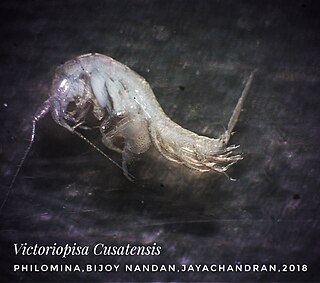
Bivalvia, in previous centuries referred to as the Lamellibranchiata and Pelecypoda, is a class of marine and freshwater molluscs that have laterally compressed bodies enclosed by a shell consisting of two hinged parts. As a group, bivalves have no head and they lack some usual molluscan organs, like the radula and the odontophore. The class includes the clams, oysters, cockles, mussels, scallops, and numerous other families that live in saltwater, as well as a number of families that live in freshwater. The majority are filter feeders. The gills have evolved into ctenidia, specialised organs for feeding and breathing. Most bivalves bury themselves in sediment, where they are relatively safe from predation. Others lie on the sea floor or attach themselves to rocks or other hard surfaces. Some bivalves, such as the scallops and file shells, can swim. Shipworms bore into wood, clay, or stone and live inside these substances.

Mytilopsis sallei, the black-striped mussel, is a small marine bivalve mollusc in the family Dreissenidae, the false mussels.
The Dreissenidae are a family of small freshwater mussels, aquatic bivalve molluscs. They attach themselves to stones or to any other hard surface using a byssus. The shells of these bivalves are shaped somewhat like those of true mussels, and they also attach themselves to a hard substrate using a byssus; however, this group is not at all closely related to true mussels, being more closely related to the venus clams (Veneridae).

The Unionidae are a family of freshwater mussels, the largest in the order Unionida, the bivalve molluscs sometimes known as river mussels, or simply as unionids.

Corbicula is a genus of freshwater and brackish water clams, aquatic bivalve mollusks in the family Cyrenidae, the basket clams. The genus name is the Neo-Latin diminutive of Latin corbis, a basket, referring to the shape and ribs of the shell.

Mya is a genus of saltwater clams, marine bivalve molluscs in the family Myidae. They are widespread and abundant in northern waters. Commonly known as Ipswich clams, soft-shell clam or steamers, they are routinely used as a food source for humans.
Freshwater bivalves are one kind of freshwater mollusc, along with freshwater snails. They are bivalves that live in fresh water as opposed to salt water, which is the main habitat type for bivalves.

Myidae, common name the softshell clams, is a taxonomic family of marine bivalve molluscs in the order Myida.

Mytilopsis leucophaeata is a species of small bivalve mollusc in the false mussel family, Dreissenidae. It is commonly known as Conrad's false mussel or the dark false mussel.

Kayamkulam Kayal, Kayamkulam Lake or Kayamkulam Estuary is a shallow brackish water lagoon stretching between Panmana and Karthikapally. It has an outlet to the Arabian sea at Kayamkulam barrage. The Kayal used to be connected to the sea most of the time except during dry season when a bar like formation separates it from the sea. Now the bar has been opened up permanently for construction of Kayamkulam Fishing Harbor. Kayamkulam boat race is conducted in Kayamkulam Kayal.

Potamocorbula is a genus of very small saltwater clams, marine bivalve molluscs in the subfamily Erodoninae of the family Corbulidae in the order Myida.

Theora mesopotamica is a species of saltwater and brackish water clam, a bivalve mollusk in the family Semelidae. This species is known from the northwestern end of the Persian Gulf, and from subfossil remains in brackish deposits in the lower Tigris–Euphrates basin of Iraq.

Mytella strigata is a bivalve, commonly known as the charru mussel or charrua mussel. This species was described by Sylvanus Charles Thorp Hanley based on a specimen from the Philippines. It was found in Central and South America and by Alcide d'Orbigny, a French naturalist, in 1842, where it was assigned the synonym Mytilus charruanus. They are less than an inch long (2.5 cm), and range from brown to black in color.
Stygarctus is a genus of tardigrades in the family Stygarctidae. It was named by Erich Schulz in 1951. The name is a combination of Greek Styx and arktos ("bear").

Nassodonta insignis is a species of brackish water snail, with gills and an operculum, a gastropod mollusk in the family Nassariidae.

Victoriopisa cusatensis is a amphipod species in the family Eriopisidae. The species name ‘cusatensis’ refers to the Cochin University of Science and Technology (CUSAT). This species has been described by the team of researchers in 2018 from the Valanthakad mangrove area of Vembanad backwater.

Indosphenia is a genus of bivalves belonging to the family Myidae. This genus is mainly distributed in the fragmented brackish water habitats of India including Chilka Lake and Cochin (kochi) backwaters.

Stygarctus keralensis is a species of marine tardigrade. It is described from the intertidal area of Vadakara beach, Kerala it can be easily differentiated from closely related species S. gourbaultae. This species was described by groups of researchers namely N.K. Vishnudattan, S. Bijoy Nandan and P.R. Jayachandran of Cochin University of Science and Technology, Kerala, India and J.G. Hansen of University of Copenhagen, Denmark. This species has been named after "Kerala State" situated in the south west coast of India where this species live. The present discovery is an outcome of an ongoing Ministry of Earth Sciences-National Centre for Earth Science Studies study on the ecology and diversity of submarine groundwater habitats of Kerala led by Sivasankaran Bijoy Nandan.

Sivasankaran Bijoy Nandan is a professor at the Department of Marine Biology, Microbiology & Biochemistry, School of Marine Sciences, Cochin University of Science & Technology (CUSAT). He currently appointed as Vice Chacellor of Kannur University and holds the office of the Dean, Faculty of Marine Sciences, Cochin University of Science and Technology. He is also syndicate and senate member of CUSAT. He was served as Head of the department, Department of Marine Biology, Microbiology and Biochemistry, CUSAT during 2019-2021 period. He has expertise in teaching, research, and development activities in the broad area of Aquatic Ecosystem Characterisation, Conservation, Restoration and Management, Carbon Dynamics & Community Ecology, Communities Ecology & Biology, Eco-toxicology and Biology of Polar Communities. Recently a new species of deep sea wood boring mollusc collected from eastern Arabian Sea named after Prof. Bijoy Nandan as Xylophaga nandani by team of Researchers from Brazil and India namely, Marcel Velásquez, P.R. Jayachandran & M. Jima. Recently, a crab species discovered along the Kerala coast was named Aniptumnus bijoyi in honor of Bijoy, as recognized by Hari, Hershey, and Mendoza in 2022.















